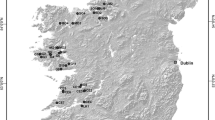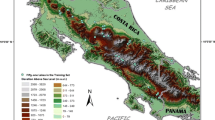Abstract
Water depth is an important environmental variable that explains a significant portion of the variation in the chironomid fauna of shallow lakes. We developed site-specific and local chironomid water-depth inference models using 26 and 104 surface-sediment samples, respectively, from seven kettlehole lakes in the Plymouth Aquifer, southeast Massachusetts, USA. Our site-specific model spans a depth gradient of 5.6 m, has an \( {\text{r}}_{\text{jack}}^{2} \) of 0.90, root mean square error of prediction (RMSEP) of 0.5 m and maximum bias of 0.7 m. Our local model has a depth gradient of 11.7 m, an \( {\text{r}}_{\text{jack}}^{2} \) of 0.71, RMSEP of 1.6 m and maximum bias of 2.9 m. Principal coordinates of neighbourhood matrices (PCNM) analysis showed that there is no influence of spatial autocorrelation on the site-specific model, but PCNM variables explained a significant amount of variance (4.8%) in the local model. This variance, however, is unique from the variance explained by water depth. We applied the inference models to a Holocene chironomid record from Crooked Pond, a site for which multiple, independent palaeohydrological reconstructions are available. The chironomid-based reconstructions are remarkably similar and show stable water depths of ~5 m, interrupted by a 2-m decrease between 4,200 and 3,200 cal a BP. Sedimentological evidence of water level fluctuations at Crooked Pond, obtained using the so-called Digerfeldt approach, also shows a drop in water depths around that time. The period of reconstructed lower water levels coincides with the abrupt decline in moisture-dependent hemlock in this region, providing further evidence for this major palaeohydrological event. The site-specific model has the best performance statistics, but the high percent abundance of fossil taxa from the long core that are absent or rare in the training set makes the site-specific reconstruction unreliable for the period before 4,400 cal a BP. The fossil taxa are well represented in the local model, making it the preferred inference model. The strong similarity between the chironomid-based reconstructions and the independent palaeohydrological records highlights the potential for using chironomid-based inference models to determine past lake depths at sites where temperature was not an influencing factor.








Similar content being viewed by others
References
Barley EM, Walker IR, Kurek J, Cwynar LC, Mathewes RW, Gajewski K, Finney BP (2006) A northwest North American training set: distribution of freshwater midges in relation to air temperature and lake depth. J Paleolimnol 36:295–314
Bennett KD (1996) Determination of the number of zones in a biostratigraphical sequence. New Phytol 132:155–170
Bennett KD, Fuller JL (2002) Determining the age of the mid-Holocene Tsuga canadensis (hemlock) decline, eastern North America. Holocene 12:421–429
Birks HJB (1995) Quantitative palaeoenvironmental reconstructions. In: Maddy D, Brew JJ (eds) Statistical modelling of quaternary science data. Quaternary Research Association, Cambridge, pp 161–254
Birks HJB (1998) Numerical tools in palaeolimnology—progress, potentialities, and problems. J Paleolimnol 20:307–332
Birks HJB, Gordon AD (1985) Numerical methods in Quaternary pollen analysis. Academic Press, London
Birks HJB, Line JM, Juggins S, Stevenson AC, ter Braak CJF (1990) Diatoms and pH reconstruction. Philos Trans R Soc Lond B 327:263–278
Blanchet FG, Legendre P, Borcard D (2008) Forward selection of explanatory variables. Ecology 89:2623–2632
Borcard D, Legendre P (2002) All-scale spatial analysis of ecological data by means of principal coordinates of neighbour matrices. Ecol Model 153:51–68
Brodersen KP, Anderson NJ (2002) Distribution of chironomids (Diptera) in low arctic West Greenland lakes: trophic conditions, temperature and environmental reconstruction. Freshw Biol 47:1137–1157
Brodersen KP, Quinlan R (2006) Midges as palaeoindicators of lake productivity, eutrophication and hypolimnetic oxygen. Quat Sci Rev 25:1995–2012
Brodersen KP, Odgaard BV, Vestergaard O, Anderson NJ (2001) Chironomid stratigraphy in the shallow and eutrophic Lake Søbygaards, Denmark: chironomid-macrophyte co-occurrence. Freshw Biol 46:253–267
Bronk Ramsey C (2008) Deposition models for chronological records. Quat Sci Rev 27:42–60
Brooks SJ, Birks HJB (2001) Chironomid-inferred air temperatures from Lateglacial and Holocene sites in north-west Europe: progress and problems. Quat Sci Rev 20:1723–1741
Brooks SJ, Bennion H, Birks HJB (2001) Tracing lake trophic history with a chironomid-total phosphorus inference model. Freshw Biol 46:513–533
Brooks SJ, Langdon PG, Heiri O (2007) The identification and use of Palaearctic Chironomidae larvae in palaeoecology. Quat Res Assoc Tech Guide 10:276
Brugam RB, Owen B, Kolesa L (2004) Continental-scale climate forcing factors and environmental change at Glimmerglass Lake in the upper Peninsula of Michigan. The Holocene 14:807–817
Cwynar LC, Rees ABH, Pedersen CR, Engels S (2012) Depth distribution of chironomids and an evaluation of site-specific and regional lake-depth inference models: a good model gone bad? J Paleolimnol. doi:10.1007/s10933-012-9628-z
Digerfeldt G (1986) Studies on past lake-level fluctuations. In: Berglund BE (ed) Handbook of Holocene Palaeoecology and Palaeohydrology. Wiley, Chichester, pp 127–142
Dray S, Legendre P, Peres-Neto PR (2006) Spatial modelling: a comprehensive framework for principal coordinate analysis of neighbour matrices (PCNM). Ecol Model 196:483–493
Eggermont H, Kennedy D, Hasiotis ST, Verschuren D, Cohen A (2008) Distribution of living larval Chironomidae (Insecta: Diptera) along a depth transect at Kigoma Bay, Lake Tangayika: implications for palaeoenvironmental reconstruction. Afr Entomol 16:162–184
Engels S, Cwynar LC (2011) Changes in fossil chironomid remains along a depth gradient: evidence for common faunal thresholds within lakes. Hydrobiologia 665:15–38
Foster DR, Oswald WW, Faison EK, Doughty ED, Hansen BCS (2006) A climatic driver for abrupt mid-Holocene vegetation dynamics and the hemlock decline in New England. Ecology 87:2959–2966
Glew J (1991) Miniature gravity corer for recovering short sediment cores. J Paleolimnol 25:101–110
Haas JN, McAndrews JH (2000) The summer drought related hemlock (Tsuga canadensis) decline in Eastern North America 5700 to 5100 years ago. In: McManus K (ed) Proceedings: Symposium on Sustainable Management of Hemlock Ecosystems in Eastern North America. USDA Forest Service General Technical Report NE-267, 81–88
Hansen BP, Lapham WW (1992) Geohydrology and Simulated Ground-Water Flow, Plymouth–Carver Aquifer, Southeastern Massachusetts. United States Geological Survey Water Resources Investigation Report 90-4204, Marlborough, MA
Heiri O (2004) Within-lake variability of subfossil chironomid assemblages in shallow Norwegian lakes. J Paleolimnol 32:67–84
Heiri O, Lotter AF, Hausmann S, Kienast F (2003) A chironomid-based Holocene summer air temperature reconstruction from the Swiss Alps. The Holocene 13:477–484
Juggins S (2007) C2 user guide. University of Newcastle, Newcastle upon Tyne, UK, Software for ecological and palaeoecological data analysis and visualisation
Korhola A, Olander H, Blom T (2000) Cladoceran and chironomid assemblages as quantitative indicators of water depth in subarctic Fennoscandian lakes. J Paleolimnol 24:43–54
Kurek J, Cwynar LC (2009) The potential of site-specific and local chironomid-based inference models for reconstructing past lake levels. J Paleolimnol 42:37–50
Laird KR, Cumming BF (2008) Reconstruction of Holocene lake level from diatoms, chrysophytes and organic matter in a drainage lake from the Experimental Lakes Area (northwestern Ontario, Canada). Quat Res 69:292–305
Laird KR, Cumming BF (2009) Diatom-inferred lake level from near-shore cores in a drainage lake from the Experimental Lakes Area, northwestern Ontario, Canada. J Paleolimnol 42:65–80
Langdon PG, Ruiz Z, Brodersen KP, Foster IDL (2006) Assessing lake eutrophication using chironomids: understanding the nature of community response in different lake types. Freshw Biol 51:562–577
Legendre P, Gallagher ED (2001) Ecologically meaningful transformations for ordination of species data. Oecologia 129:271–280
Legendre P, Borcard D, Blanchet G, Dray S (2010) PCNM: PCNM spatial eigenfunction and principal coordinate analyses. R package version 2.1/r82, http://R-Forge.R-project.org/projects/sedar/
Levesque AJ, Cwynar LC, Walker IR (1997) Exceptionally steep north south gradients in lake temperatures during the last deglaciation. Nature 385:423–426
Lotter AF, Juggins S (1991) POLPROF, TRAN and ZONE: programs for plotting, editing and zoning pollen and diatom data. Inqua-Subcommission for the study of the Holocene, Working Group on Data-Handling Methods Newsletter 6:4–6
Luoto TP (2009) A Finnish chironomid- and chaoborid-based inference model for reconstructing past lake levels. Quat Sci Rev 28:1481–1489
Luoto TP (2010) Hydrological change in lakes inferred from midge assemblages through use of an intralake calibration set. Ecol Monogr 80:303–329
Newby PE, Killowan P, Waldorf M, Shuman B, Webb T III (2000) 14,000 years of sediment, vegetation and water level changes at the Makepeace Cedar Swamp, southeastern Massachusetts. Quat Res 53:352–368
Newby PE, Donnelly JP, Shuman B, MacDonald D (2009) Evidence of centennial-scale drought from southeastern Massachusetts during the Pleistocene/Holocene transition. Quat Sci Rev 28:1675–1692
Oksanen J, Blanchet FG, Kindt R, Legendre P, O’Hara RB, Simpson GL, Solymos P, Henry M, Stevens H, Wagner H (2011) Vegan: Community Ecology Package. R package version 1.17-10. http://CRAN.R-project.org/package=vegan
Porinchu DF, Cwynar LC (2000) The distribution of freshwater Chironomidae (Insecta: Diptera) across treeline near the lower Lena River, northeast Siberia. Arct Antarct Alp Res 32:429–437
Reimer PJ, Baillie MGL, Bard E, Bayliss A, Beck JW, Blackwell PG, Bronk Ramsey C, Buck CE, Burr GS, Edwards RL, Friedrich M, Grootes PM, Guilderson TP, Hajdas I, Heaton TJ, Hogg AG, Hughen KA, Kaiser KF, Kromer B, McCormac FG, Manning SW, Reimer RW, Richards DA, Southon JR, Talamo S, Turney CSM, van der Plicht J, Weyhenmeyer CE (2009) IntCAL09 and Marine09 radiocarbon age calibration curves. Radiocarbon 51:1111–1150
Rück A, Walker IR, Hebda R (1998) A palaeolimnological study of Tugulnuit Lake, British Columbia, Canada, with special emphasis on river influence as recorded by chironomids in the lake’s sediment. J Paleolimnol 19:63–75
Shuman BN, Donnelly JP (2006) The Influence of Seasonal Precipitation and Temperature Regimes on Lake Levels in Northeastern United States during the Holocene. Quat Res 65:44–56
Shuman BN, Bravo J, Kaye J, Lynch JA, Newby P, Webb T III (2001) Late-Quaternary water-level variations and vegetation history at Crooked Pond, southeastern Massachusetts. Quat Res 56:401–410
Shuman BN, Newby P, Huang Y, Webb T III (2004) Evidence for the close climatic control of New England vegetation history. Ecology 85:1297–1310
Shuman BN, Bartlein PJ, Webb T III (2007) Response to ‘‘Comments on: ‘The magnitude of millennial- and orbital-scale climatic change in eastern North America during the Late-Quaternary’ by Shuman et al”. Quat Sci Rev 26:268–273
Shuman BN, Newby P, Donnelly JP (2009) Abrupt climate change as an important agent of ecological change in the northeast US throughout the past 15,000 years. Quat Sci Rev 28:1693–1709
R Development Core Team (2011) R: A language and environment for statistical computing. R Foundation for Statistical Computing, Vienna. ISBN 3-900051-07-0. http://www.R-project.org/
Ter Braak CJF, Šmilauer P (2002) CANOCO Reference Manual and CanoDRAW for Windows user’s guide: software for canonical community ordination (v 4.5). Microcomputer Power, Ithaca
Walker IR, Smol JP, Engstrom DR, Birks HJB (1991) An assessment of Chironomidae as quantitative indicators of past climatic change. Can J Fish Aquat Sci 48:975–987
Wiederholm T (1983) Chironomidae of the Holarctic region. Keys and diagnoses. Part I. Larvae. Entomol Scand 19:1–457
Yu Z, McAndrews JH, Eicher U (1997) Middle Holocene dry climate caused by change in atmospheric circulation patterns: evidence from lake levels and stable isotopes. Geology 25:251–254
Acknowledgments
We are grateful to Jeremiah Marsicek, Grace Carter and Jacqueline Gill for their assistance in the field. We thank Stephanie Koch (US Fish and Wildlife Service) for permission to perform fieldwork at Crooked Pond. Donna Francis and Brian Cumming are thanked for constructive criticism on an earlier draft of this manuscript. Daniel Borcard and Christopher Bronk Ramsey provided invaluable support during the PCNM and OxCal analyses, for which we are grateful. Two anonymous reviewers, Associate Editor Steve Brooks and Editor Mark Brenner are thanked for useful suggestions that helped improve this paper. Funding by the Niels Stensen Foundation for SE is greatly appreciated. This research was funded in part by a Discovery Grant to LCC from the Natural Sciences and Engineering Research Council of Canada. Funding to BNS by the U.S. National Science Foundation (EAR-0602408; EAR-1036191; DEB-0816731) also provided support for core collection, radiocarbon analyses, and sediment analyses at the University of Wyoming.
Author information
Authors and Affiliations
Corresponding author
Rights and permissions
About this article
Cite this article
Engels, S., Cwynar, L.C., Rees, A.B.H. et al. Chironomid-based water depth reconstructions: an independent evaluation of site-specific and local inference models. J Paleolimnol 48, 693–709 (2012). https://doi.org/10.1007/s10933-012-9638-x
Received:
Accepted:
Published:
Issue Date:
DOI: https://doi.org/10.1007/s10933-012-9638-x




